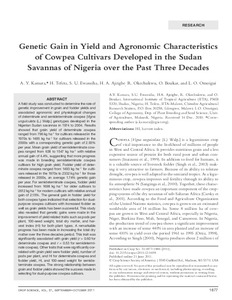| dc.contributor.author | Kamara, A.Y. |
| dc.contributor.author | Tefera, H. |
| dc.contributor.author | Ewansiha, S.U. |
| dc.contributor.author | Ajeigbe, Hakeem A. |
| dc.contributor.author | Okechukwu, R.U. |
| dc.contributor.author | Boukar, O. |
| dc.contributor.author | Omoigui, L.O. |
| dc.date.accessioned | 2019-12-04T11:08:47Z |
| dc.date.available | 2019-12-04T11:08:47Z |
| dc.date.issued | 2011-09 |
| dc.identifier.citation | Kamara, A.Y., Tefera, H., Ewansiha, S.U., Ajeigbe, H.A., Okechukwu, R., Boukar, O. & Omoigui, L.O. (2011). Genetic gain in yield and agronomic characteristics of cowpea cultivars developed in the Sudan savannas of Nigeria over the past three decades. Crop science, 51(5), 1877-1886. |
| dc.identifier.issn | 0011-183X |
| dc.identifier.uri | https://hdl.handle.net/20.500.12478/1908 |
| dc.description.abstract | A field study was conducted to determine the rate of genetic improvement in grain and fodder yields and associated agronomic and physiological changes of determinate and semideterminate cowpea [Vigna unguiculata (L.) Walp.] genotypes developed in the Nigerian Sudan savannas in 1974 to 2004. Results showed that grain yield of determinate cowpea ranged from 796 kg ha−1 for cultivars released in the 1970s to 1485 kg ha−1 for cultivars released in the 2000s with a corresponding genetic gain of 2.93% per year. Mean grain yield of semideterminate cowpea ranged from 638 to 1547 kg ha−1 with relative annual gain of 4.4%, suggesting that more progress was made in breeding semideterminate cowpea cultivars for high grain yield. Fodder yield of determinate cowpea ranged from 1493 kg ha−1 for cultivars released in the 1970s to 2332 kg ha−1 for those released in 2000s, an average 1.74% genetic gain per year. For semideterminate cowpea, fodder yield increased from 1698 kg ha−1 for older cultivars to 2612 kg ha−1 for modern cultivars with relative annual gain of 2.15%. The general gain in fodder yield for both cowpea types indicated that selection for dual-purpose cowpea cultivars with increased fodder as well as grain yields has been successful. This study also revealed that genetic gains were made in the improvement of yield related traits such as pods per plant, 100-seed weight, total dry matter, and harvest index (HI) for both plant types. A remarkable progress has been made in increasing the total dry matter over the three decades period. This trait was significantly associated with grain yield (r = 0.60 for determinate cowpea and r = 0.53 for semideterminate cowpea). Other traits that were significantly correlated with grain yield were fodder yield, number of pods per plant, and HI for determinate cowpea and fodder yield, HI, and 100-seed weight for semideterminate cowpea. The strong relationship between grain and fodder yields showed the success made in selecting for dual-purpose cowpea cultivars. |
| dc.format.extent | 1877-1886 |
| dc.language.iso | en |
| dc.subject | Cowpeas |
| dc.subject | Fodder |
| dc.subject | Crop Yield |
| dc.subject | Genetic Gain |
| dc.subject | Agronomic Characteristics |
| dc.subject | Cultivars |
| dc.title | Genetic gain in yield and agronomic characteristics of cowpea cultivars developed in the Sudan savannas of Nigeria over the past three decades |
| dc.type | Journal Article |
| dc.description.version | Peer Review |
| cg.contributor.affiliation | International Institute of Tropical Agriculture |
| cg.contributor.affiliation | Chitedze Agricultural Research Station, Malawi |
| cg.contributor.affiliation | University of Agriculture, Makurdi |
| cg.coverage.region | Africa |
| cg.coverage.region | West Africa |
| cg.coverage.country | Nigeria |
| cg.isijournal | ISI Journal |
| cg.authorship.types | CGIAR and developing country institute |
| cg.iitasubject | Agronomy |
| cg.iitasubject | Cowpea |
| cg.iitasubject | Grain Legumes |
| cg.journal | Crop Science |
| cg.howpublished | Formally Published |
| cg.accessibilitystatus | Limited Access |
| local.dspaceid | 85022 |
| cg.targetaudience | Scientists |
| cg.identifier.doi | http://dx.doi.org/10.2135/cropsci2010.12.0698 |

